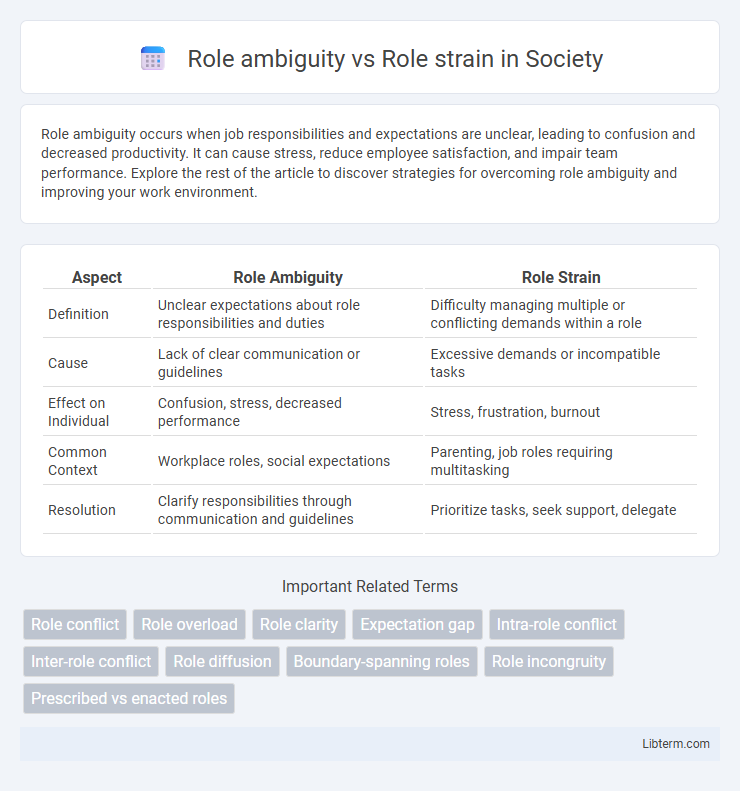Role ambiguity occurs when job responsibilities and expectations are unclear, leading to confusion and decreased productivity. It can cause stress, reduce employee satisfaction, and impair team performance. Explore the rest of the article to discover strategies for overcoming role ambiguity and improving your work environment.
Table of Comparison
| Aspect | Role Ambiguity | Role Strain |
|---|---|---|
| Definition | Unclear expectations about role responsibilities and duties | Difficulty managing multiple or conflicting demands within a role |
| Cause | Lack of clear communication or guidelines | Excessive demands or incompatible tasks |
| Effect on Individual | Confusion, stress, decreased performance | Stress, frustration, burnout |
| Common Context | Workplace roles, social expectations | Parenting, job roles requiring multitasking |
| Resolution | Clarify responsibilities through communication and guidelines | Prioritize tasks, seek support, delegate |
Understanding Role Ambiguity: Definition and Examples
Role ambiguity occurs when individuals lack clear information about their job responsibilities, expectations, or scope of authority, leading to confusion and decreased performance. Common examples include employees unclear about specific duties or conflicting instructions from multiple supervisors, which disrupt workflow and increase stress. This uncertainty often results in reduced job satisfaction and higher turnover rates.
Defining Role Strain: Key Characteristics
Role strain occurs when an individual faces difficulty in fulfilling the expectations of a single role due to conflicting demands, lack of resources, or insufficient time. Key characteristics include feelings of stress, frustration, and reduced performance within the role, often resulting from ambiguous responsibilities or unrealistic expectations. Unlike role ambiguity, which centers on unclear role definitions, role strain specifically highlights the emotional and cognitive burden experienced while trying to meet role requirements.
Comparing Role Ambiguity and Role Strain
Role ambiguity occurs when individuals lack clarity about their job responsibilities, expectations, or scope of authority, leading to confusion and decreased performance; role strain arises when conflicting demands within a role cause stress and difficulty fulfilling responsibilities. Role ambiguity primarily involves unclear information and uncertainty, while role strain is associated with the pressure and tension from competing role demands. Studies show that role ambiguity often results in low job satisfaction and increased turnover intentions, whereas role strain correlates more with burnout and emotional exhaustion.
Causes of Role Ambiguity in the Workplace
Role ambiguity in the workplace arises when employees lack clear information about their job responsibilities, expectations, and authority, leading to confusion and decreased performance. This can be caused by poorly defined job descriptions, inconsistent communication from management, and conflicting instructions from multiple supervisors. In contrast, role strain occurs when individuals feel overwhelmed by the demands of their roles despite understanding their responsibilities clearly.
Sources of Role Strain in Professional Settings
Role strain in professional settings often stems from conflicting job demands, unclear performance expectations, and insufficient resources to complete assigned tasks effectively. High workloads and time pressures contribute to stress, while inadequate support from supervisors or colleagues exacerbates the difficulty in fulfilling role obligations. Unlike role ambiguity, which arises from unclear role definitions, role strain specifically results from the tension experienced when the expectations of a clearly defined role exceed an individual's capacity or available resources.
Psychological Impact of Role Ambiguity
Role ambiguity occurs when individuals lack clear information about their job responsibilities, leading to confusion and stress that can negatively impact mental health. Psychological consequences of role ambiguity include increased anxiety, job dissatisfaction, and decreased motivation due to uncertainty and inability to meet expectations effectively. Understanding and addressing role ambiguity is essential for improving employee well-being and enhancing organizational productivity.
Effects of Role Strain on Employee Performance
Role strain occurs when employees face conflicting demands within a single role, leading to stress and decreased job satisfaction. This strain reduces concentration, motivation, and efficiency, directly impairing overall performance and productivity. Persistent role strain can increase absenteeism and turnover, adversely impacting organizational stability and employee morale.
Strategies to Reduce Role Ambiguity
Role ambiguity occurs when job expectations are unclear, leading to confusion and decreased performance, whereas role strain refers to the stress experienced when job demands exceed an individual's capacity. To reduce role ambiguity, organizations should implement clear job descriptions that specify responsibilities and performance criteria, provide regular feedback and open communication channels between supervisors and employees, and offer targeted training to clarify expectations. Effective role clarification strategies promote employee confidence, enhance productivity, and reduce workplace stress.
Effective Solutions for Minimizing Role Strain
Role strain occurs when individuals experience difficulty meeting the demands of a single role due to conflicting expectations or insufficient resources, while role ambiguity arises from unclear role definitions and expectations. Effective solutions for minimizing role strain include clarifying role responsibilities through detailed job descriptions and consistent communication from supervisors, providing adequate resources and training to enhance competence, and fostering supportive workplace environments that encourage open feedback and teamwork. Implementing these strategies reduces stress, improves role clarity, and enhances overall job performance.
Role Ambiguity vs Role Strain: Implications for Organizational Success
Role ambiguity occurs when employees lack clear expectations or understanding of their job responsibilities, leading to confusion and decreased productivity. Role strain arises when individuals face conflicting demands or excessive pressure within their role, causing stress and reduced job satisfaction. Addressing both role ambiguity and role strain is crucial for organizational success, as clarity in role definitions enhances employee performance and managing role strain improves overall workplace well-being and retention.
Role ambiguity Infographic

 libterm.com
libterm.com